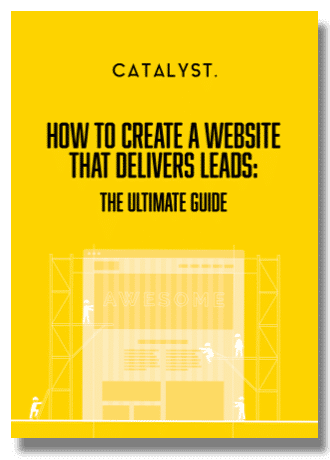Do you know how well your website is performing?
Chances are, if you’re not properly using website analytics, the answer is no.
But that’s okay – analytics are a difficult thing to get into and manage. The Catalyst team do this for a living, meaning that we know exactly what metrics you need to know, and what types of software you need in order to get the data you need to improve your online presence.
In this blog, we’ll run through the importance of website analytics. We’ll also touch on some of the most useful pieces of software you should be using in order to understand:
- Who is coming to your website?
- What are they doing when they’re on your website?
- Where are they finding your website?
- Why are they leaving your website?
Let’s start with some general background on what website analytics are.
What are website analytics, and why are they so important?
Website analytics refers to the collection, measurement, analysis, and reporting of data related to a website’s performance and user interactions.
These analytics provide valuable insights into how your website is used, its audience, and its overall effectiveness. There are various tools and platforms available to gather this data, with Google Analytics being one of the most popular.
No decisions to edit your website should ever be made without analytics – you wouldn’t make an important business decision without knowing exactly what position it would leave you in, would you?
Many businesses haphazardly change things on their website, then are shocked to find that their website isn’t driving as many leads as before. It’s very easy to inadvertently ruin your website’s performance, which is why it’s essential that you have the right tracking software in place and make informed decisions, not random guesses.
What are the different types of website tracking software?
Traffic analytics
Traffic analytics tools are designed to monitor and analyse both your website’s traffic and the user interactions that are happening within.
For example, HubSpot’s tracking software is fantastic at tracking website visitors, page views, content analytics (seeing how well your blogs and other content is performing) and conversion tracking.
This data allows you to identify which pages are working best, and optimise other pages to suit.
Google Analytics, as mentioned, is another fantastic traffic analysis tool that is incredibly popular in businesses across the world. GA4 (the latest version) provides in-depth insights into user behaviour on your website, and includes:
- Event tracking: GA4 emphasises event-based tracking, allowing you to monitor specific user interactions like button clicks, video views, and more.
- User-centric tracking: GA4 offers a more user-centric approach, helping you understand user journeys and the path users take through your site.
- Machine learning and Predictive Metrics: GA4 incorporates machine learning to provide predictive metrics and insights into user trends.
- Audience and user segmentation: GA4 enables you to segment your audience based on user attributes, behaviour, and engagement.
How do traffic analytics benefit your business?
Traffic analytics are one of the most important tools in any marketer’s toolbox. The data gathered allows you to:
- Understand user behaviour – Traffic analytics tools help you understand how users interact with your website or app. You can see which pages they visit, how long they stay, and the paths they take through your site. This allows you to make UX improvements as and when required.
- Optimise your content – By analysing what content is the most popular, and what content isn’t performing as you’d hoped, you can tailor your content strategy to prioritise the content that resonates with your audience, while eliminating less effective content.
- Improve conversion rates – Conversion rate optimisation is an important part of any website journey. Your website is never ‘done’, it’ll always need optimising to stay ahead. Traffic analytics allow you to identify where users drop off in your funnel, allowing you to make specific adjustments in these areas.
- Optimise SEO – Traffic analytics provide you insight into the keywords used to find your site in search engines like Google. This is essential for search engine optimisation (SEO), as you’ll be able to further optimise your content to better target the keywords that are working.
Keyword rankings
Keyword ranking tools such as SEMrush and Moz are used predominantly for SEO purposes.
It’s impossible to properly perform good SEO without knowing what the keywords you should be targeting are, otherwise you’re guessing once again.
These tools provide valuable insights and data to help website owners, marketers, and SEO professionals optimise their online presence and improve their search engine rankings.
They allow you to:
- Conduct keyword research – Helping you see clearly what people are actually searching for.
- Perform competitor analysis – This shows you how well your competitors’ websites are performing.
- Track your website’s ranking – See clearly where your website is ranking, allowing you to make careful adjustments moving forward.
How does knowing keyword rankings benefit your business?
SEO is incredibly important; we cannot stress that enough. The difference in being at the top of Google versus in 2nd, 3rd, or, God forbid, on page 2, is huge.
To demonstrate (data from Search Engine Watch):
- 1st position gets on average 32.5% of clicks
- 2nd position gets on average 17.6% of clicks
- 3rd position gets on average 11.4% of clicks
- Second page and onwards gets less than 1% of clicks
More clicks = more potential customers/clients. It’s simple – SEO tools are the only way you’ll be able to build a truly successful SEO strategy; you can’t do this without data.
User behaviour
User behaviour tools, like Hotjar, are designed to help you gain insights into how users interact with your websites. These tools use a variety of tracking and analytics features to understand user behaviour and improve the user experience, such as:
- Heat mapping – Hotjar provides heat maps that visually represent where users click, move their mouse, and scroll on your website. These heatmaps help you identify which parts of your pages are the most and least engaging, allowing you to make data-driven design decisions.
- Session recording – It also allows you to record user sessions, capturing mouse movements, clicks, and keystrokes. These recordings provide a real-time view of how users navigate and interact with your website, helping you spot usability issues and areas of improvement.
- Feedback, surveys and polls – Providing opportunities for people to provide direct feedback is really important. Hotjar allows you to create on-site surveys and feedback forms that can be triggered based on user behaviour.
- Conversion analysis – You can create conversion funnels in Hotjar to track how users progress through specific user flows, such as a sign-up process or a checkout process. This feature helps you identify drop-off points and optimise conversion rates.
How does understanding user behaviour benefit your business?
These tools are all about user experience (UX); helping make your website as pleasurable as possible to browse.
Fail to create a great website with a good UX, and potential customers will drop off. Understanding user behaviour is really important as it allows you to rectify issues before they become serious, meaning you can make your website a genuine pleasure to browse, one that people actually want to visit!
Prospect insight
There are a variety of prospect insight tools on the market, with our favourite being Lead Forensics.
Now, it’s not perfect, but it does help you to identify and gain valuable insights into the companies and individuals visiting your website.
This tool tracks and analyses website traffic and provides information about anonymous website visitors, allowing you to convert these visitors into potential leads or customers.
How does gaining prospect insight benefit your business?
Knowing exactly who is visiting your website is essential.
Even if they don’t convert on that visit, you’ll know they’ve been, and you can nurture that lead in other ways, perhaps through marketing automation, or with targeted account-based marketing.
This is especially exciting if you see people from the same company repeatedly visiting your website. At this point, you know that there’s a conversation going on about you, making it a really good opportunity for you to reach out and say hello.
They’ll think it’s a coincidence, you’ll know that it’s not!
Data-driven marketing from the experts
At Catalyst, it’s our belief that no marketing success happens without the backing of great data.
Time and time again we’re told that ‘marketing doesn’t work’. When we ask businesses what website analytics they’re using, they look back at us blankly.
Don’t worry – we get that it can be a little overwhelming; we’re here to help.


